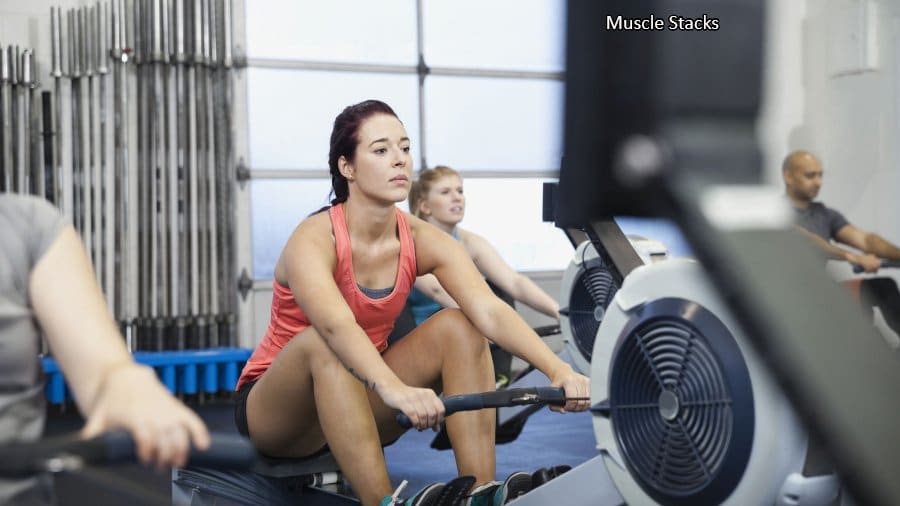Aerobic exercise is a large component of cardiovascular fitness: individuals who engage in aerobic exercise may be doing it for the sole purpose of weight loss, or they may have other motivations, such as increasing VO2, becoming more efficient, lowering blood pressure, decreasing resting heart rate, or they may not know why except to become “healthier”, but whatever the motivation, there are guidelines to the aerobic fitness approach that will help to reach your goal more quickly and proficiently.
The concept is simple, the more work you do, the more calories you burn; however, you can manipulate this concept to fit your needs, timeframe, and preferences. You see, cardio can be broken down into parts (low, moderate, and high volumes). Based on which volume you choose to employ, you can perform a lower intensity for a longer duration of time, a higher intensity for a shorter period of time, or somewhere in between.
All of these volumes are based on whatever your maximal heart rate value is. And to figure that out is simple: 220 – AGE. That’s it! You take the number 220 and you subtract from it your current age. That will give you a value that is your heart rate max. For example: if a 25-year-old woman wants to determine her max HR, she would take 220 and subtract 25 to receive a value of 195. 195 is her max HR. Based on this value, she can determine her low, moderate, and high-intensity ranges.
Cardiovascular Intensity Differences
Low-intensity cardiovascular exercise is performed at less than 60% of maximal heart rate. Technically, low-intensity aerobic exercise is the most beneficial in burning fat for fuel, as compared to carbohydrate and protein. This is important to note because fat is the most efficient use of energy compared to both proteins and carbs. In every gram of fat, there are 9 calories. Which means that if you are burning fat for energy, you are dispensing a larger amount of energy (aka calories); thus, causing quicker weight loss.
On the other hand, both carbs and proteins only contain 4 calories per gram, making them less efficient. While this seems like the most effective option in losing weight, it does have a downside. Low-intensity cardio has to be performed at less than 60% of heart rate max for greater than 45 minutes. For those who enjoy reading, watching TV, or listening to music while doing their cardio, this is perfect! But for those who have more strenuous schedules, it may not be ideal.
Cardiovascular exercise of greater than 85% of HR max will fall into the high-intensity category. Unlike low-intensity cardio, high intensity requires a higher output of work, but with less frequency. In this case, cardio may be performed at a greater intensity for a short period of time (<20 minutes). It will yield similar results in terms of fat loss; however, it has a greater potential to maintain (or increase) muscle mass.
High-intensity exercise generates energy via carbohydrate sources, unlike low-intensity exercise, which uses fat sources, to perform work. As stated earlier, carbohydrates only contain 4 calories per gram making them less efficient than fat sources. However, the rate at which the energy is being expended nearly negates the efficiency differences as high-intensity exercise burns more calories faster, it still produces a fat mass deficit.
Somewhere in the middle lies moderate intensity cardiovascular fitness. It takes components of both high and low-intensity modalities and combines the two. For instance, moderate intensity cardio is performed between 60% and 85% HR max and its benefits may be observed at approximately 35 minutes of exercise. Likewise, moderate intensity exercise uses both carb and fat sources for fuel. This mode of cardio is probably the most attractive to users as it is relatively time effective and does not require an abundance of strenuous work.
Measuring Heart Rate Intensity
Knowing your heart rate max is the first step to determining at what intensity you are exercising or at what intensity you want to exercise. As stated earlier, heart rate max is determined to utilize a simple formula (220 – age = HR max). But you may be wondering how to determine what your heart rate is and how to figure out the intensity at which it is performing. This next step is a bit more difficult, but doable nonetheless.
Find a place to take your pulse: I tend to choose the carotid artery (runs along both sides of the neck) because it is the easiest for me to find. No matter the intensity I’m working at, I’m able to find my pulse quickly on that artery. Another common artery to find your pulse is on the radial artery. If you hold your palms facing away from your body or up to the ceiling, the radial artery is located on the lateral side of the wrist (the side furthest way from your body). While there are certainly other places to find your pulse, these are the two easiest ways during exercise.
Once you’ve found your pulse, pull out a stopwatch. Count the number of pulses you feel for 10 seconds. After you’ve determined what that number is, multiply it by 6 (there are 60 seconds in 1 minute…60 divided by 10 = 6). That will give you your current heart rate. But you’re not done there! Remember when you determined what your max heart rate is? Now’s the time when that number is going to come in handy. Take your predetermined max heart rate value and divide it by your current heart rate to determine at what intensity you’re exercising.
Knowing your intensity of exercise will allow you to generate the greatest benefit in cardiovascular fitness your way. These 3 simple steps allow you to keep track of your agenda while maintaining your schedule and reaching your fitness goals. *Note: the information discussed in this article reflects pre-resistance training aerobic exercise. Cardiovascular fitness post-resistance training varies depending on how much “work” was done during that training session. Often times, the amount of cardio performed post-workout is generally lower than what would need to be done prior to weight lifting.
Read More: Female Bodybuilding Myths



